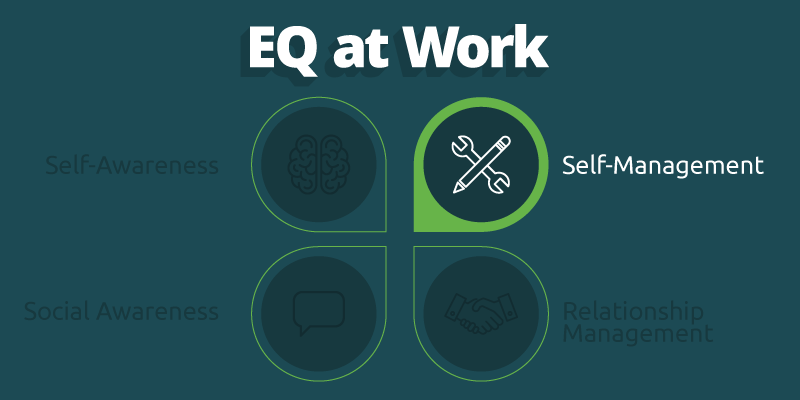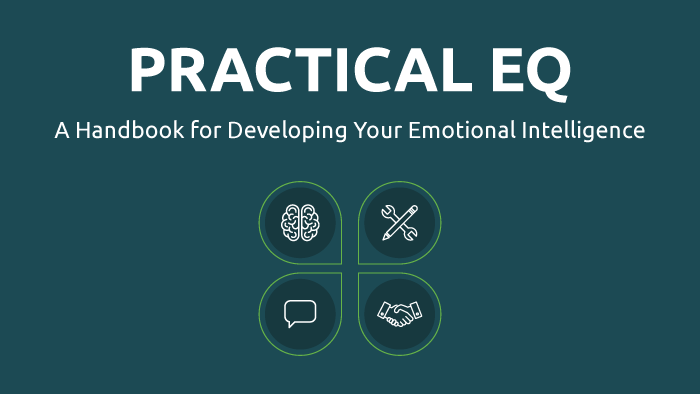This article is part two of our EQ at Work series – be sure to check out part one on developing employees’ self-awareness, part three on social awareness, and part four on relationship management!
“No man is free who cannot command himself.”
– Pythagoras
Encouraging Employees to Improve Self-Management Skills
In the first article of the EQ at Work series, we talked about why improving emotional intelligence starts with self-awareness. People can’t manage their behaviors for the best outcomes if they’re not in tune with their genuine thoughts and emotions. Hopefully your employees are well on their way to improving self-awareness with the strategies and practices outlined in our free guide.
What we’ve noted before and we’ll say again here is the importance of gaining employees’ buy-in with emotional intelligence training. Improving EQ isn’t about following a checklist or memorizing a process – it takes committed practice and intentional reflection.
When it comes to the self-management domain of EQ, the rewards for improving skills in this area can be both intrinsic and extrinsic, so if you’re struggling to gain employee buy-in for EQ training, highlight reasoning from both aspects on why this is beneficial to everyone.
Extrinsic rewards could be seen through improved job performance – likelihood for greater commissions, bonuses, perks, or promotions. People skilled in self-management are able to build stronger relationships and perform higher quality work, which are essentials for moving up in a career and gaining a higher salary.
Intrinsic rewards include factors like meaningfulness, purpose, performing with competence, ownership of work, satisfaction, etc. – all the hallmarks of highly engaged employees. These rewards are not “granted” by an organization – they’re the psychological outcome of employees recognizing the value of their work.
In the case of complicated skill development like EQ and self-management, those intrinsic rewards are your greatest ally. Author Annie McKee says that extrinsic rewards won’t get you too far, but instead, “What does work is a) helping people find a deep and very personal vision of their own future and b) then helping them see how their current ways of operating might need a bit of work if that future is to be realized.”
Online videos are a simple way to get employees’ attention on the topic of self-management, and can be used in tandem with several other strategies to encourage continued EQ development.
We offer a large online learning library for organizations to use for improving employees’ skills across a range of topics, including soft skills and EQ.
Click the play button to preview this video on self-management, and see more videos from our library here!
Acting on Self-Awareness
Many people don’t realize the ways they are acting on their emotions or the effects those behaviors have on other people. That’s why starting with self-awareness is crucial – then they can use that awareness to consciously and intentionally choose their responses.
Self-management is all about responding, not reacting.
That doesn’t mean learning to ignore emotions. It means handling them appropriately, rather than pretending they’re not there or acting out of reactive instinct. The goal is to respond in a way that helps people or situations, rather than hurting them.
This means giving emotions time and consideration, the length and depth of which varies depending on the circumstances.
There’s a lot that goes into those two little words, so let’s discuss some self-management strategies you can train employees to use for responding to their emotions.
Some Self-Management Strategies
By engaging in practices to increase self-awareness, your employees can then translate that understanding of themselves into behavioral application through self-management techniques.
Here are a few they can practice to build their skills:
Choosing a Chair
Louise Evans, a behavioral coach and author, has developed a brilliant strategy for managing how we respond to emotions that arise. She calls it The Five Chairs, and it provides a mental cue to pause and think through what we’ll say or do next. Here’s a quick overview:
The Attack chair – this is the chair where we hunker down in the “I’m right” mindset, choosing to put our pride ahead of others’ emotions and well-being.
The Self-Doubt chair – in this chair, we discourage ourselves, choosing to put fear, self-judgment, or a victim mentality at the forefront of our thoughts and behaviors.
The Wait chair – when we choose the Wait chair, we pause, step back and look at the situation objectively, and ask “why” questions to gain perspective and understanding.
The Detect chair – here is where we choose to become self-aware, to know who we are and what we need, and to be assertive in that (not aggressive).
The Connect chair – this chair is about choosing compassion and empathy, and listening to others without our ego in the way.
Visualizing these chairs and consciously choosing the Wait chair before going to either Attack or Self-Doubt can help us to move more quickly into Detect and Connect.
Breaking out of Rumination
Negative feelings are like a high school house party. It starts with just a couple people hanging out, then more and more invite themselves over and pretty soon it’s totally out of control.
Ruminating on a situation and dwelling on the negative emotions it brought up can quickly turn into a downward spiral, effectively closing us off from positive realities and causing us to drag others down, too. That’s when it’s time to call the cops on yourself and break up that negative mindset!
In this case, the dispatcher is gratitude.
Even the tiniest bit of thankfulness can snap us out of rumination and pull us back to rational thought. Once gratitude takes over, it won’t be long until more positive emotions enter the scene.
Seeking Feedback
We judge ourselves by our intentions, but we judge others by their actions. That makes it easy to let ourselves off the hook because we know our heart was in the right place, even though we may see someone else do the exact same thing and we criticize them for it.
Asking for feedback about our behaviors and how we respond in emotional situations can be immensely helpful, albeit difficult to swallow sometimes. The closest relationships work best for this, since acquaintances aren’t likely to be as accurate or honest.
Just like self-awareness, self-management takes practice. Emotional intelligence skills don’t spring up overnight, but when you’re dedicated to helping your employees improve their EQ, expect to start seeing some positive changes at work.
“Can we all commit to making our homes, our workplaces, and this world a better place, one behavior at a time?”
– Louise Evans
To help your employees develop emotional intelligence, check out our free handbook with simple practices and reflection questions:
Read part one: EQ at Work: Developing Employees’ Self-Awareness
Read part three: EQ at Work: Amplify Empathy for Higher Social Awareness
Read part four: EQ at Work: Relationship Management Fundamentals

